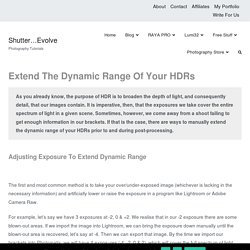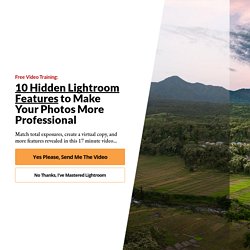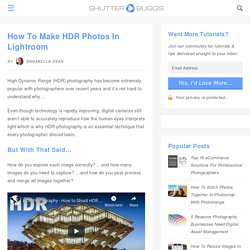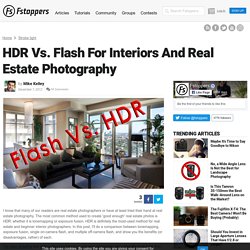

Extend The Dynamic Range Of Your HDRs - Shutter...Evolve. As you already know, the purpose of HDR is to broaden the depth of light, and consequently detail, that our images contain.

It is imperative, then, that the exposures we take cover the entire spectrum of light in a given scene. Sometimes, however, we come away from a shoot failing to get enough information in our brackets. If that is the case, there are ways to manually extend the dynamic range of your HDRs prior to and during post-processing. Adjusting Exposure To Extend Dynamic Range The first and most common method is to take your over/under-exposed image (whichever is lacking in the necessary information) and artificially lower or raise the exposure in a program like Lightroom or Adobe Camera Raw.
For example, let’s say we have 3 exposures at -2, 0 & +2. This only works in RAW, which you absolutely must be shooting in. Best Method To Extend The Dynamic Range This is the example image we’ll work with – a vertorama of a church in Paris Raw Output Before Changes 1. 2. 3. 4. 5. 6. 7. Flash Vs. HDR For Interiors And Real Estate Photography, Part II: Mood And Color Case Study.
About six months ago, I wrote a piece comparing flash techniques to HDR and ambient-only techniques when shooting for architecture and interiors clients.

There was some great discussion involved and many valid points raised, and I'd like to take a few minutes to bring up another scenario that really shows the benefits of using flash whenever possible when dealing with interior or architectural situations. We'll be looking at how flash can add mood and control color, something we didn't touch on in too much depth in the last iteration of this article. Every week, I get a ton of questions from photographers looking to get into architecture and interiors photography, something I've been working hard on for years now (here's my portfolio, if you don't trust me), and one of the more common questions is how to deal with color casts and how to use light when shooting interiors.
Test shot So, first things first. Test shot without ambient, faster shutter speed Which is admittedly pretty terrible. How to Use HDR for Real Estate Photography. We’ve all heard a lot about HDR photography, but we seem to hear more about the bad examples than the good ones!

How To Make HDR Photos In Lightroom. High Dynamic Range (HDR) photography has become extremely popular with photographers over recent years and it’s not hard to understand why… Even though technology is rapidly improving, digital cameras still aren’t able to accurately reproduce how the human eyes interprets light which is why HDR photography is an essential technique that every photographer should learn.

But With That Said… How do you expose each image correctly? …and how many images do you need to capture? …and how do you post-process and merge all images together? In this video tutorial, professional photographer Phil Steele will show you how to take HDR photos and how to merge them together using Lightroom. Lightroom’s Photo Merge For HDR Photos Adobe Lightroom has amassed an amazing array of features over the years, including “Photo Merge” for high dynamic range photographs. Simply, select five bracketed exposures that you would like to merge together to create your HDR image. But With That Said… 6 tips voor een maximaal dynamisch bereik in je foto's. Maandag 18 januari 2016, 20:40 door Piet van den Eynde | 8067x gelezen | 7 reacties Heb je het ook al eens gehad?

Het landschap ziet er fantastisch uit maar op de foto krijg je veel te lichte luchten en een veel te donkere voorgrond. Of je fotografeert je vriendin voor het raam van je hotelkamer in New York. Achter haar heb je een prachtig zicht op de skyline. Alleen... bij je foto's zijn ofwel je vriendin onderbelicht ofwel is de skyline vervangen door een witte vlek. Zelfs de duurste camera ziet nu eenmaal de realiteit anders dan onze ogen.
Een camera-sensor werkt anders: die vangt gewoon licht zoals een emmertje water opvangt. Je kan natuurlijk compenseren daarvoor door krapper te belichten, maar bij scènes met een groot dynamisch bereik dreig je dan detail in de schaduwen te verliezen. Gelukkig zijn er een aantal dingen die je kan doen om het dynamisch bereik van je camera, en dus van je foto's, te verbeteren. 1. 2. High Dynamic Range Imaging within Lightroom CC. HDR Vs. Flash For Interiors And Real Estate Photography. I know that many of our readers are real estate photographers or have at least tried their hand at real estate photography.

The most common method used to create 'good enough' real estate photos is HDR: whether it is tonemapping or exposure fusion, HDR is definitely the most-used method for real estate and beginner interior photographers. In this post, I'll do a comparison between tonemapping, exposure fusion, single on-camera flash, and multiple off-camera flash, and show you the benefits (or disadvantages, rather) of each. I've been shooting and writing about architecture, interiors, real estate, and generally everything that needs to look pretty but cannot be moved for awhile now, and it seems every time I post an article related to my field(s), there are plenty of comments debating the use of HDR and the use of flash in the comments.
Flash users insult HDR users, HDR users insult flash users, everyone cuts a knee open, and everyone goes home disappointed. The Scene Single exposure. Flash Vs. HDR For Interiors And Real Estate Photography, Part II: Mood And Color Case Study.